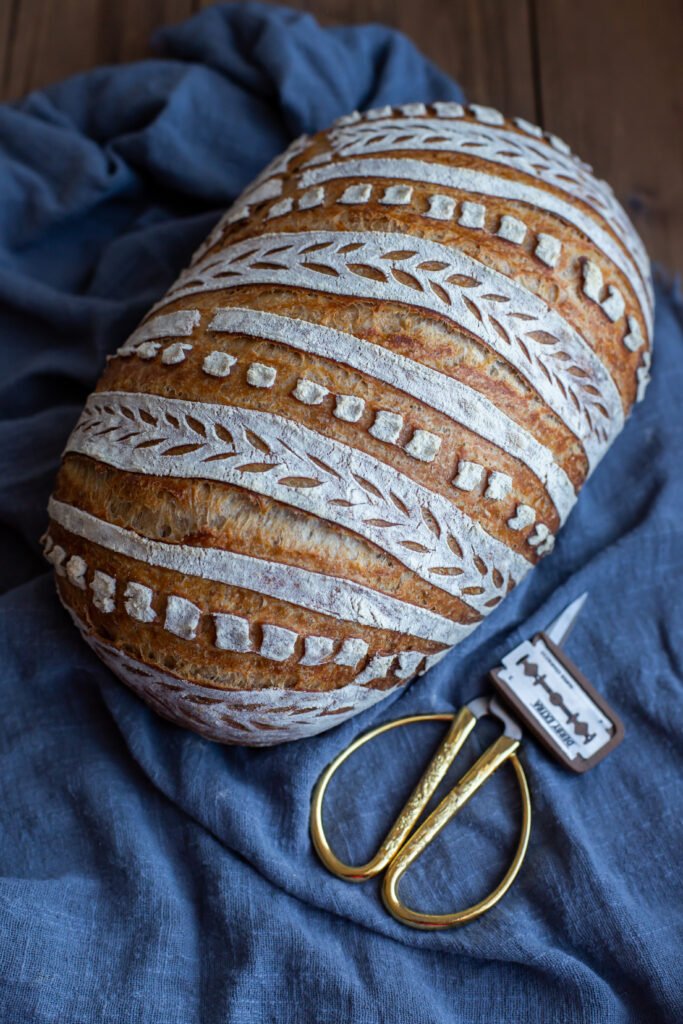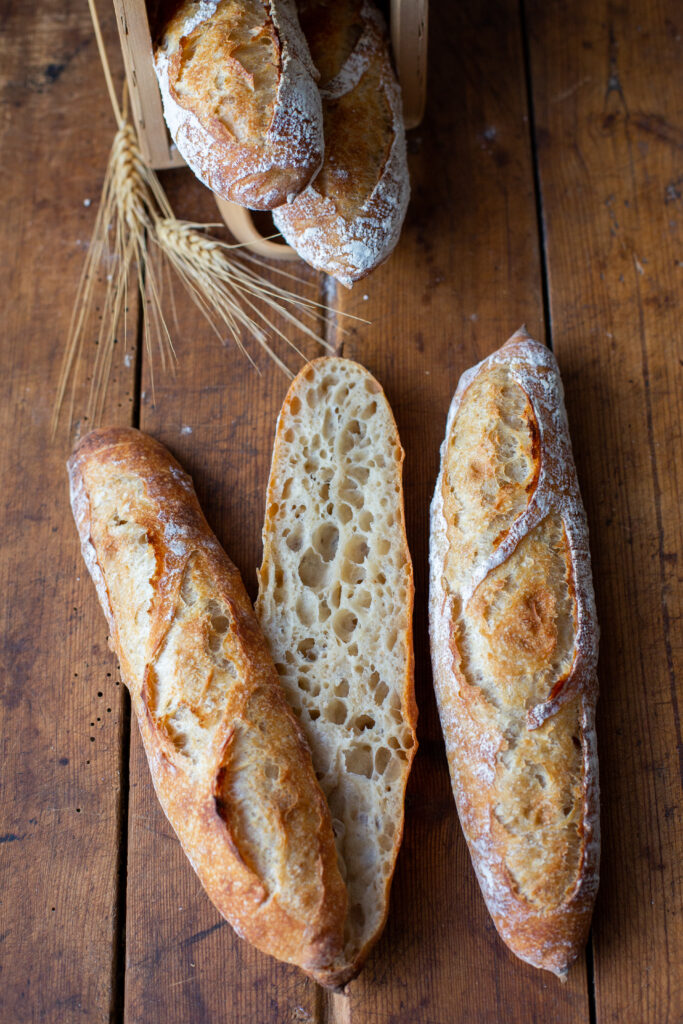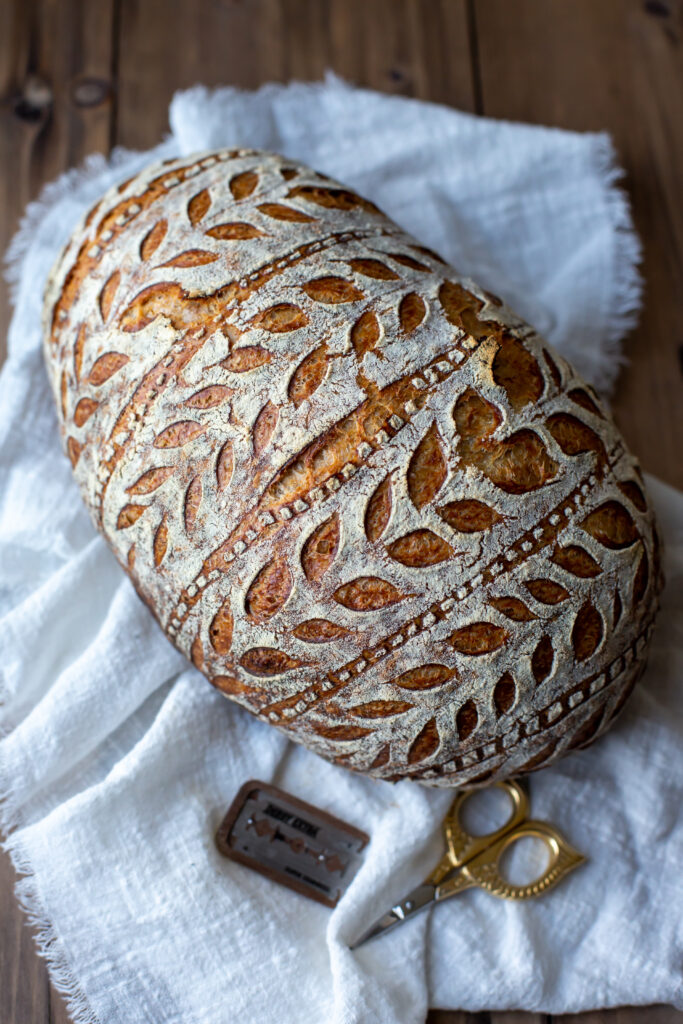Hi friends! I’ve gotten a few requests to share how to build your own sourdough starter from scratch.

While this is a relatively easy process, it does take some time. And every person’s kitchen is a little different, so this is really just a helpful guideline to get started.

I also wanted to preface this by saying that you do not have to make your own starter if you don’t want to. There are many options to purchase one online, OR my favorite tip for someone who just wants to get baking is to ask your favorite local bakery (that makes sourdough obviously) if they would be willing to give you some of theirs.
As a previously professional baker in a bakery, we would be asked occasionally to share some of our bakery sourdough starter, and we were always happy to give it away for free.

BUT either way, I did want to share a small-batch sourdough starter guide for those who want to start their own. This is a small-batch starter to reduce waste. You can always increase the proportions if desired, just keep the ratios of water, flour and starter the same throughout your process.

Small-Batch Sourdough Starter
 https://mostlysourdough.com/wp-content/uploads/2023/03/BH1A8681-scaled.jpg
https://mostlysourdough.com/wp-content/uploads/2023/03/BH1A8681-scaled.jpg
How to build a small batch sourdough starter from scratch to reduce waste.
You'll Need...
- 200 grams all purpose flour
- 200 grams whole wheat flour
- Water
- 8 ounce jar (preferably 2, to switch off)
Directions
- Day 1: Make your starter food: Combine 200 grams white bread flour with 200 grams of either your rye or whole wheat (whatever you want your starter to be) in a container or bag. You will use this mixture to feed your starter over the next week. In an 8 ounce jar, add 15 grams of room temperature water and 15 grams of the flour mixture. Mix together until well combined, and there are no dry bits. Cover loosely (you do not want it to be airtight), and store in a warm space for 24 hours. If your house is cold (68 or below), use warmer water (80-85 degrees) in your mixture.
- Day 2: Time to feed your starter! Try to do this at the same time that you created the starter the previous day. Stir up your starter mixture and scoop out 5 grams. In a small bowl or second jar, add 15 grams water, 15 grams of the flour mixture, and the 5 grams of starter. Mix until thoroughly combined. If you mixed it in a bowl, transfer it back into your original jar after discarding the leftover mixture. **You will now have some discard. At this point the discard is not really useful and there is very little of it, so you can just compost or toss it. If you feel bad throwing it away, add it to some pancake batter or in some other recipe by swapping out equal parts liquid and flour (the same goes for the rest of the discard through this process). Store your starter in a warm space again loosely covered for 24 hours.
- Day 3: You may start to see some small bubbles at this stage, but if not, don’t worry (sometimes it takes longer to see activity)! At the same time as the previous day, feed your starter again following the same process as Day 2. Stir up the starter mixture, scoop out 5 grams. In a small bowl or another jar, add 15 grams water, 15 grams of the flour mixture, and the 5 grams of starter. Mix until thoroughly combined. If you mixed it in a bowl, transfer it back into your original jar (give the jar a rinse to keep things tidy and clean if you aren’t using a second jar) after discarding the leftover mixture. Store your starter in a warm space again loosely covered for 24 hours.
- Day 4: Today, we begin feeding the starter twice a day! In the morning and evening. In the morning, you may see signs of activity. You might see some streaks on the sides of the jar showing where it has risen and then fallen. Good signs! Feed the starter in the morning following the same feeding process as before. Stir up the starter mixture, scoop out 5 grams. In a small bowl or another jar, add 15 grams water, 15 grams of the flour mixture, and the 5 grams of starter. Mix until thoroughly combined. If you mixed it in a bowl, discard the previous leftover starter, and transfer the new starter back into your jar. Let rest in a warm space for 12 hours.
- After 12 hours, feed the starter in the evening the same way. Stir up the starter mixture, scoop out 5 grams. In a small bowl or another jar, add 15 grams water, 15 grams of the flour mixture, and the 5 grams of starter. Mix until thoroughly combined. If you mixed it in a bowl, discard the previous leftover starter, and transfer the new starter back into your jar. Let rest in a warm space for 12 hours.
- Days 5 & 6: Continue feeding and discarding twice a day (in the morning and evening, 12 hours apart).
- Day 7 and on: Feed the starter in the morning following the same feeding process as before. Stir up the starter mixture, scoop out 5 grams. In a small bowl or another jar, add 15 grams water, 15 grams of the flour mixture, and the 5 grams of starter. Mix until thoroughly combined. If you mixed it in a bowl, discard the previous leftover starter, and transfer the new starter back into your jar. Let rest in a warm space for 12 hours.
- By now, you might have a starter that is consistently rising and falling. You’ll be able to tell if your starter is alive and established if it is bubbly/active, and if it doubles in size within 4-8 hours. Basically, you’re looking for consistency, so when you feed it is rising and falling within the same timeframe. You will want to keep feeding your starter every 12 hours when kept at room temperature, but each starter is slightly different. Look for the signs of it reaching its peak and beginning to fall. You want to feed it just before it falls ideally.
- If your starter doesn’t seem to be growing or rising consistently, be patient and keep with the feeding schedule. Some starters take longer to mature or become reliable (sometimes it takes several weeks or even over a month). As long as you don’t see any mold form, continue the feedings until you see it predictably rising/falling. After your starter is established and mature you can store it in the refrigerator so you don’t have to feed it as often. Remember that this process is very forgiving. Don’t worry too much about getting the exact quantities correct or forgetting to feed it right on time. The only ways to truly mess this up is to neglect your starter for a super long time, cross contamination/mold, or if the starter experiences extreme temperatures. If something does happen, another consistent cycle of feedings can get you right back on track in most cases.
- Once your starter is established, feel free to increase the size of your starter for bigger batches, just be sure to follow the same ratios of starter, flour and water.
Additional Notes
This can also be made with larger quantities, just keep the ratio the same.
Adapted from Tartine Bread and I am A Food Blog
Feel free to reach out with any questions or if you run into any trouble. I’m also happy to send some of my starter by mail and might look into having that as an option to buy on my site.
Leave a Reply